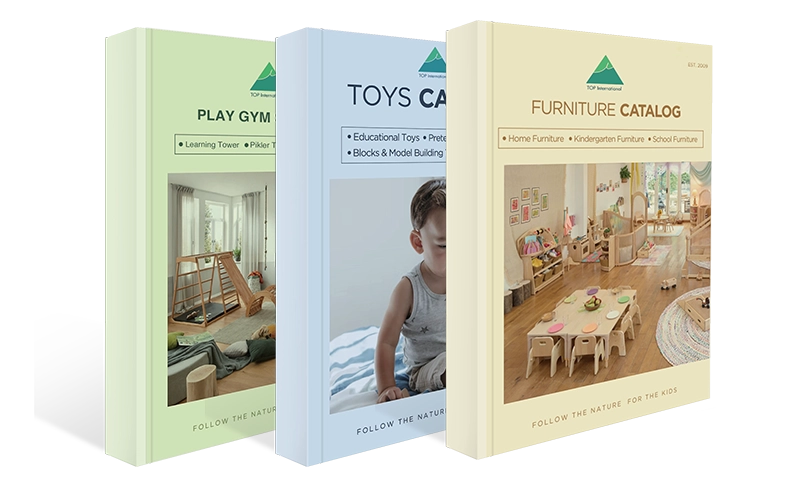Are you looking for ways to help your preschooler develop more potent physical and cognitive abilities? Perceptual motor skills are crucial for your child’s growth. They play a significant role in developing basic and complex skills for academic success and daily life. Are you wondering why your preschooler struggles with balance, coordination, or simple daily tasks? Do they have trouble sitting still, holding a pencil, or following instructions?
Improving perceptual motor skills can solve these challenges by enhancing physical coordination, sharpening focus, and supporting early learning development. These skills help children gain independence, perform better academically, and interact more confidently with their environment. When nurtured early, these abilities can prevent learning delays, reduce frustration, and promote a more enjoyable, successful preschool experience.
بالتأكيد! المهارات الإدراكية والحركية أساسية في نمو الطفولة المبكرة. فهي ضرورية للمهام الجسدية، والنمو المعرفي، والتفاعلات الاجتماعية. إتقان هذه المهارات يُمكّن أطفال ما قبل المدرسة من المشاركة في أنشطة متنوعة تُشكّل تجاربهم الأكاديمية والعاطفية.
1. What Are Perceptual Motor Skills?
Perceptual motor skills involve receiving, interpreting, and responding to sensory information through coordinated physical movements. These skills integrate sensory inputs—such as sight, sound, and touch—with motor output, including walking, catching, writing, or balancing. These skills are essential for preschoolers, forming the foundation for academic learning, social interaction, and everyday independence.
When children see a ball approaching them and instinctively raise their hands to catch it, they use perceptual and motor skills. Their eyes process the speed and direction of the ball, and their brain coordinates the appropriate muscular response. This synchronization of senses and movement is critical for physical activities and tasks like reading, where visual motor perceptual skills help track words across a page, or writing, which relies heavily on fine motor skills and visual guidance.
These skills evolve naturally through play and exploration, but can also be supported through intentional activities. Games that involve balance, hand-eye coordination, or spatial awareness, such as puzzles, obstacle courses, or ball games, are excellent perceptual motor skills activities. Strengthening these skills early helps children improve focus, build confidence, and adapt more easily to structured learning environments. Putting, understanding, and nurturing perceptual motor skills equips preschoolers with tools for lifelong success in both physical and academic pursuits.
2. The Science Behind Perceptual Motor Skills
Perceptual motor skills are not simply about physical movement. They represent a highly intricate network of neural processes, brain structures, and sensory feedback loops that shape a child’s ability to interact with their environment. These skills allow children to move purposefully, learn from movement, and adapt to physical challenges.
Understanding the neurological foundation of perceptual motor development is critical to early childhood education, therapeutic intervention, and informed parenting. Research has shown that the human brain undergoes substantial structural and functional changes during preschool. These changes are particularly pronounced in motor control, balance, and sensory integration.
Below, we explore the three most influential brain regions involved in developing perceptual motor skills: the cerebellum, the motor cortex, and the sensory cortex.
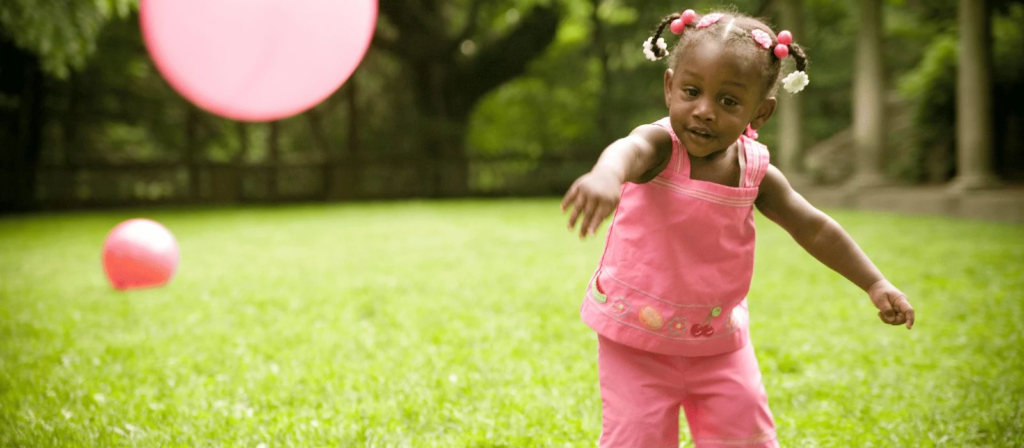
2.1 Cerebellum
The cerebellum, located at the base of the brain, plays a central role in motor control. While it does not initiate movement, it is crucial for coordination, precision, and accurate timing. The cerebellum receives information from the sensory systems, the spinal cord, and other brain parts, and integrates these inputs to fine-tune motor activity.
In preschoolers, the cerebellum supports:
- Balance and Posture: It helps children maintain equilibrium as they move, whether jumping, running, or sitting still. This is especially crucial in hopping on one foot or walking a balance beam, where even minor miscalculations can lead to falls or stumbles.
- Motor Learning: It plays a vital role in learning new movements. When a child first attempts to use scissors or knows how to throw a ball, the cerebellum adjusts their motor patterns with repeated practice, gradually leading to more fluid, efficient movements.
- Predictive Timing: The cerebellum helps children anticipate the timing of moving objects, such as catching a ball or jumping rope.
Developmental delays or underdevelopment in the cerebellum can result in clumsy movements, difficulty with rhythm, and problems with coordination. Children with these challenges may appear awkward or avoid physical activities due to fear of failure or embarrassment.
2.2 Motor Cortex
The motor cortex generates voluntary motor movements, particularly the primary motor cortex. Located in the frontal lobe, it sends signals to the body’s muscles, allowing a child to move intentionally.
For young children, the motor cortex is actively involved in:
- Initiating Movement: Whether a child raises their hand, throws a ball, or claps to music, the motor cortex is firing neural impulses to specific muscles, making those actions possible.
- Gross and Fine Motor Control: Larger body movements such as running or jumping rely on the gross motor areas, while intricate actions like buttoning a shirt or drawing require fine motor control, governed by different regions within the motor cortex.
- Skill Refinement: As children practice physical tasks, the motor cortex refines its control over muscles, improving precision. For example, early attempts at writing may be shaky, but with repetition, the motor cortex strengthens its neural pathways for smoother control.
This region is particularly plastic in early childhood, meaning it can adapt and change quickly in response to learning and environmental input. This neuroplasticity underscores the importance of providing diverse and repeated movement experiences during preschool.
2.3 Sensory Cortex
The sensory cortex, especially the somatosensory area in the parietal lobe, processes sensory information such as touch, temperature, pressure, and proprioception (the sense of body position).
In the context of perceptual motor skills, the sensory cortex:
- Translates Sensory Input into Action: When a child feels the texture of a puzzle piece or the weight of a ball, the sensory cortex interprets that data, allowing the brain to adjust motor output accordingly.
- Supports Proprioception: This internal sense helps a child know where their limbs are in space without looking. For example, reaching for a cup without knocking it over depends on accurate proprioceptive input and response.
- Enables Tactile Discrimination: Differentiating between surfaces, textures, or temperatures helps children interact safely and effectively with their environments.
Children with sensory processing issues may receive distorted information from their environment, leading to over- or under-reactions. A light touch may feel like a poke, or they may seem unaware when they bump into something. These inconsistencies can affect their confidence, self-regulating ability, and overall development.

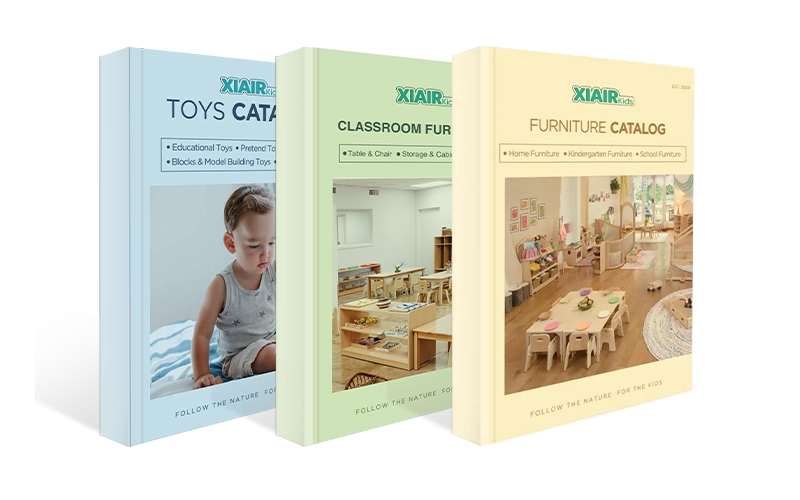
Receive a free catalog and custom layout to help you design your ideal classroom easily.
3. Why Is Perceptual Motor Skills Development Important?
Developing perceptual motor skills is vital for preschoolers because it lays the foundation for physical coordination, academic readiness, and social interaction. These skills help children process sensory information and translate it into purposeful movement, like writing, balancing, or following directions. Strong perceptual and motor skills enhance focus, boost confidence, and support independence in daily tasks. Children may struggle with learning, behavior, and basic motor functions without them. Early development ensures smoother transitions into structured learning environments and sets the stage for long-term success.
3.1 Types of Perceptual and Motor Skills
- المهارات الحركية الكبرى:تشمل هذه الحركات مجموعات عضلية كبيرة، وتساعد الأطفال على المشي والقفز وأنشطة التوازن. المهارات الحركية الكبرى أساسية للنمو البدني.
- المهارات الحركية الدقيقة:المهارات الحركية الدقيقة هي حركات أصغر وأكثر دقة تتضمن اليدين والأصابع، مثل التقاط الأشياء الصغيرة، أو التلوين، أو حمل قلم رصاص.
Both motor and perceptual skills work together in everyday tasks. For example, when a child is running and catching a ball, they use visual motor perceptual and motor skills to complete the task. This is why preschoolers must practice both skills to support their development.

3.2 Foundation for Learning and Development
عندما يطور الأطفال مهاراتهم الحركية الإدراكية، فإنهم يضعون الأساس لنجاحهم الأكاديمي والاجتماعي في المستقبل. تساعد المهارات الحركية والإدراكية أطفال ما قبل المدرسة على التركيز، وحفظ المعلومات، وفهم العالم من حولهم. على سبيل المثال، تتطلب الكتابة مزيجًا من visual motor coordination والمهارات الحركية الدقيقة. الطفل الذي يتمتع بمهارات إدراكية أفضل المهارات الحركية سيكون أكثر مهارة في التعامل مع القلم وفهم كيفية تكوين الحروف والأرقام.
وتساهم هذه المهارات أيضًا في القدرة على حل المشكلات، واتباع التعليمات، والانخراط في المهام التي تتطلب التركيز، وهي كلها ضرورية للنجاح الأكاديمي.
3.3 Active and Independent Living
الأطفال في سن ما قبل المدرسة الذين يطورون مهارات إدراكية حركية قوية يكونون أكثر قدرة على أداء المهام اليومية باستقلالية. تتطلب الأنشطة البسيطة، مثل ارتداء الملابس وتنظيف الأسنان وتناول الطعام، مهارات حركية إدراكية حسية وتنسيقًا حركيًا. عندما يتعلم الطفل إتقان هذه المهام، يكتسب الثقة بالنفس والشعور بالاستقلالية، وهو أمر بالغ الأهمية لسلامته النفسية.
كما أن الاستقلال في هذه المهام اليومية يعزز أيضًا احترام الذات ويجهز الأطفال لمسؤوليات أكثر تعقيدًا مع تقدمهم في السن.

3.4 Brain Function and Skill Development
Engaging in activities that enhance perceptual motor skills can have a lasting impact on brain development. The brain constantly processes sensory input and directs motor actions, which strengthens neural connections and helps the brain grow. Activities that challenge a preschooler’s perceptual and motor skills lead to improved attention, memory, and problem-solving abilities.
علاوة على ذلك، فإن تطوير المهارات الحركية البصرية والإدراكية البصرية يمكن أن يحسن الوظائف الإدراكية مثل القراءة والوعي المكاني والاهتمام بالتفاصيل، وهي ضرورية للتعلم الأكاديمي.
3.5 Complex Task Practice
تُعدّ المهارات الحركية الإدراكية أيضًا بمثابة أرضية تدريب للمهام الأكثر تعقيدًا التي سيواجهها الأطفال في مراحل لاحقة من حياتهم. فالممارسة المبكرة لأنشطة المهارات الحركية الإدراكية، مثل التوازن والرسم واستخدام المقص، تُساعد الأطفال على تطوير التنسيق اللازم للمهام الأكثر صعوبة. وسيجد الطفل في مرحلة ما قبل المدرسة الذي يمارس المهارات الحركية الإدراكية ومفاهيم الحركة سهولة أكبر في الانتقال إلى الأنشطة المدرسية والرياضية المنظمة لاحقًا.
إن إتقان هذه المهارات الأساسية يجعل من السهل أيضًا على الأطفال تعلم مهام جديدة. Once children have developed the basic motor and perceptual skills needed for physical activities, they can move on to mastering other, مهارات أكثر تعقيدًا.
3.6 Everyday Activities
تعتمد الأنشطة اليومية، مثل ركوب الدراجة، أو ارتداء الملابس، أو تكديس المكعبات، على المهارات الحركية الإدراكية. هذه المهارات أساسية لأداء الطفل في العالم من حوله. على سبيل المثال، تُساعد المهارات الحركية الإدراكية، مثل التوازن على قدم واحدة أو القفز بالحبل، أطفال ما قبل المدرسة على ممارسة التنسيق الحركي والوعي المكاني.
بممارسة أطفال ما قبل المدرسة لهذه الأنشطة، يُحسّنون قدراتهم الحركية ويبنون ثقتهم بأنفسهم واستقلاليتهم. تُعدّ المهارات الحركية الإدراكية ومفاهيم الحركة أساسيةً للتعامل مع الحياة اليومية.
3.7 Perception and Motor Skills
يُعدّ الارتباط بين الإدراك والمهارات الحركية أمرًا بالغ الأهمية للنمو الشامل لمرحلة ما قبل المدرسة. تُمكّن المهارات الحركية الحسية الإدراكية الأطفال من استخدام حواسهم لتوجيه حركاتهم الجسدية. إذا واجه الطفل صعوبة في معالجة المُدخلات الحسية، فقد يؤدي ذلك إلى صعوبات في التنسيق والمهام الجسدية.
Children can improve their sensory processing abilities and motor coordination by engaging in activities that strengthen this connection, such as fun activities for perceptual motor skills or examples of perceptual motor skills involving visual tracking or tactile play.

3.8 Participate in Group Play
Group play is a cornerstone of preschool education. Children learn to take turns, cooperate, and navigate social cues through movement-based activities. Playing tag, building a fort, or dancing to music involves perceptual motor engagement.
A child with well-developed perceptual motor skills can:
- Move confidently among peers without frequent collisions or hesitation.
- Read body language and anticipate the movements of others.
- Maintain spatial awareness while respecting personal space boundaries.
Children who struggle in this area may avoid physical play, become easily overwhelmed, or appear clumsy or socially withdrawn. This can lead to exclusion from peer interactions and missed opportunities to develop essential interpersonal skills.
In contrast, strong perceptual motor abilities help children:
- Engage fully in cooperative tasks like passing a ball or forming a circle.
- Adapt their physical responses to match the intensity of group activity.
- Feel more competent, increasing their desire to participate.
When preschoolers experience success in group play, it fosters not only motor development but also self-esteem, social bonding, and emotional regulation.
3.9 Follow Multi-Step Instructions
Preschoolers are often required to follow instructions involving cognitive processing and motor responses. For example, when a teacher says, “Pick up your crayons, walk to the bin, and place them inside,” the child must integrate auditory input with memory, spatial awareness, and body movement.
Perceptual motor skills are at the core of this integration. The child needs to:
- Hear and process each component of the command.
- Understand spatial terms such as “behind,” “under,” or “next to.”
- Execute fine and gross motor actions in the correct sequence.
Children with underdeveloped skills may lose track of steps, move inefficiently, or misinterpret directions. This can frustrate both the child and the adult and may lead to behavioral issues or a false perception of inattentiveness.
On the other hand, children with refined perceptual motor abilities can:
- Navigate sequences of tasks with greater ease.
- Coordinate their actions more efficiently.
- Develop a sense of independence in responding to classroom routines.
This skill is particularly critical as children transition into kindergarten, where classroom expectations become increasingly complex.

3.10 Transition Between Activities Smoothly
Transitions—shifting from one task or setting to another—are daily events in فصول ما قبل المدرسة. Whether moving from outdoor play to circle time or changing from a block-building activity to lunch, transitions require children to shift attention, change body orientation, and regulate their physical actions.
Perceptual motor skills support smooth transitions by helping the child:
- Sense changes in the environment through visual and auditory cues.
- Adjust body posture and movement direction without stumbling or crashing.
- Understand spatial organization to find where they’re supposed to go next quickly.
Without these abilities, transitions can feel chaotic. A child may bump into others, struggle to navigate around furniture, or become overwhelmed by the shift in sensory stimuli. Such struggles often result in meltdowns, delays, or resistance to change.
However, when perceptual motor skills are intact, transitions become opportunities for independence. Children learn to:
- Follow movement-based routines with minimal prompting.
- Regulate their body in dynamic settings.
- Adapt to shifting demands with flexibility and confidence.
Effective transitions help create a rhythm to the day that is predictable and calming, both for children and their caregivers.
3.11 Develop Handwriting Readiness
Handwriting is a complex skill that demands much more than the ability to hold a pencil. It requires fine motor precision, visual-motor coordination, postural control, and spatial awareness—all components of perceptual motor development.
Preschoolers with strong perceptual motor foundations are better prepared to:
- Use appropriate grip and pressure when writing or drawing.
- Align letters on a page with consistent spacing.
- Coordinate hand and eye movements for letter formation and tracking.
Children who lack these skills may struggle with pencil control, fatigue quickly during writing tasks, or develop poor habits that become difficult to correct later. They may also avoid drawing or writing altogether, leading to academic challenges.
By contrast, early development of perceptual motor skills promotes:
- Confidence in mark-making and early literacy activities.
- Efficient motor patterns that support neat and legible writing.
- A sense of pride and ownership over their work.
Supporting handwriting readiness through perceptual motor development helps children meet academic benchmarks and enjoy learning to write.
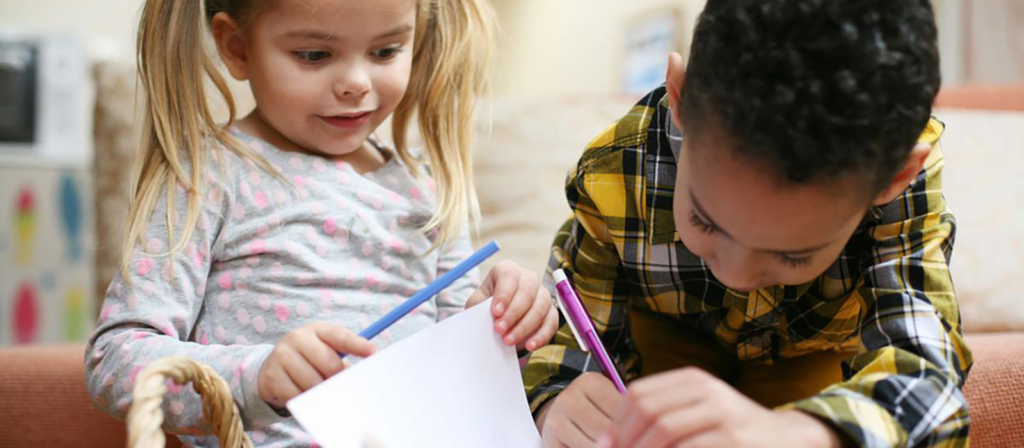
3.12 Navigate Physical Environments Safely
A preschooler’s day includes navigating hallways, climbing playground structures, stepping over objects, and exploring new spaces. Each of these actions depends on perceptual motor abilities.
For safe navigation, children need to:
- Judge distances and avoid obstacles.
- Adjust speed and direction based on terrain or surroundings.
- Maintain balance and orientation in dynamic environments.
When perceptual motor skills are weak, children may appear clumsy, have frequent accidents, or show anxiety in new settings. These issues can lead to reduced physical activity, increased adult intervention, and heightened frustration.
In contrast, children with strong skills can:
- Move through varied environments with independence and safety.
- Participate more fully in physical education and outdoor play.
- Gain physical confidence that transfers into other areas of learning.
Exploring environments safely also encourages curiosity, risk-taking, and a love of movement—all critical elements of holistic development.

Receive a free catalog and custom layout to help you design your ideal classroom easily.
4. How to Encourage Perceptual Motor Skill Development in Preschoolers?
يمكن دعم تنمية المهارات الحركية الإدراكية من خلال أنشطة منظمة وغير منظمة. إليك بعض الطرق لتنمية هذه المهارات لدى أطفال ما قبل المدرسة:
4.1 Perceptual Motor Skills Program
A structured perceptual motor skills program can give preschoolers the necessary activities and exercises to strengthen their coordination. These programs often include gross and fine motor exercises and can be adapted based on the child’s developmental level.
4.2 Perceptual Motor Skills Activities
دمج الأنشطة الممتعة والجذابة إدراجها في روتينك اليومي طريقة رائعة لدعم نموك. أنشطة بسيطة مثل:
- ألعاب الكرة (للمهارات الحركية الإجمالية)
- الألغاز والرسم (للمهارات الحركية الدقيقة)
- دورات العوائق (للتنسيق)
These perceptual motor skills activities build physical strength and coordination and enhance cognitive skills, such as problem-solving and memory.
4.3 Fun Activities for Perceptual Motor Skills
اجعل تنمية مهارات الإدراك الحركي ممتعة! أنشطة مثل الرقص، والقفز على الترامبولين، أو ممارسة الألعاب التفاعلية تساعد الأطفال على الاستمتاع. ممارسة الرياضة البدنية while developing critical coordination and sensory skills. The more fun they have, the more likely they will engage with these activities and develop stronger skills over time.
5. Examples of Perceptual Motor Skills Activities for Preschoolers
المهارات الحركية الإدراكية أساسية لمرحلة ما قبل المدرسة، إذ تُمهّد الطريق للتنسيق الحركي، والنمو المعرفي، والتطور العاطفي. من خلال المشاركة في أنشطة متنوعة للمهارات الحركية الإدراكية، يمكن لمرحلة ما قبل المدرسة بناء قدراتهم على معالجة المعلومات الحسية والاستجابة بحركات جسدية منسقة. تغطي هذه الأنشطة مهارات عديدة، من التوازن الأساسي إلى الوعي المكاني المتقدم.
What examples of perceptual motor skills activities can be integrated into a preschooler’s routine?
يمكن تقسيم الأنشطة التي تُساعد على تطوير المهارات الحركية الإدراكية إلى فئات: المهارات الحركية الكبرى، والمهارات الحركية الدقيقة، والوعي الجسدي، وغيرها. نلخص هذه الفئات أدناه، مع تقديم أمثلة عملية لكل نشاط يُساعد أطفال ما قبل المدرسة على بناء قدراتهم التنسيقية والإدراكية.
5.1 Gross Motor Activities
تُركز الأنشطة الحركية الكبرى على مجموعات عضلية أكبر، وتُساعد الأطفال على أداء حركات كبيرة، مثل الجري والقفز والتسلق. تُعزز هذه الأنشطة تنمية القوة والتنسيق والتوازن.
أمثلة على الأنشطة الحركية الكبرى
- سباقات الجريشجّع الأطفال على الركض في سباقات قصيرة داخل المنزل أو خارجه. غيّر التضاريس لإضافة تنوع، مثل الركض على تلة صغيرة أو حول مخاريط.
- القفزات:تعتبر القفزات طريقة رائعة لتطوير تنسيق الساق والذراع، كما تساعد أيضًا في تحسين صحة القلب والأوعية الدموية والتنسيق الحركي.
- ركل الكرة:ضع أهدافًا أو تحديات حيث يمكن للأطفال ركل الكرة لضرب نقطة محددة أو تسجيل "هدف". هذا يساعد على تقوية عضلات الساق مع ممارسة التنسيق بين العين والقدم.
- القفزحدّد مربعات أو دوائر على الأرض لإنشاء لعبة قفز. يستطيع الأطفال القفز من مربع إلى آخر، مما يُنمّي قوة أرجلهم وتوازنهم.
تُساعد هذه الأنشطة الحركية الكبرى على تطوير القوة والتنسيق اللازمين للمهام البدنية كالمشي والجري والقفز. كما تُعزز هذه الأنشطة المعالجة الحسية، وهو أمر أساسي للمهارات الأكاديمية والجسدية اللاحقة.

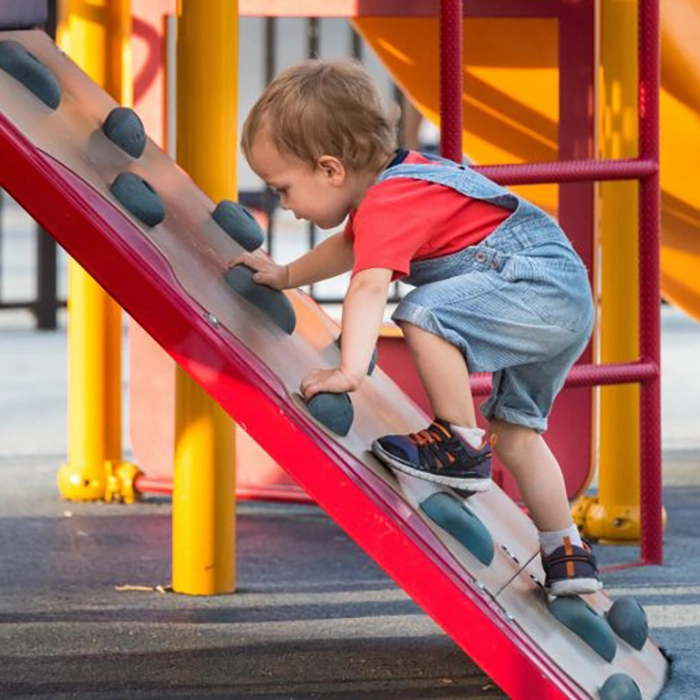
5.2 Fine Motor Activities
Fine motor activities target the smaller muscles in the hands and fingers, which are vital for writing, drawing, and eating tasks. These activities require precision and control, helping children improve their dexterity and hand-eye coordination.
أمثلة على الأنشطة الحركية الدقيقة
- الرسم والتلوين: Provide your child with crayons, markers, and coloring books to help develop visual motor perceptual skills. As they draw shapes, they practice hand control and eye-hand coordination.
- البناء بالمكعبات:تساعد الأنشطة مثل تكديس المكعبات أو تجميع الهياكل البسيطة الأطفال على ممارسة مهارات الإدراك البصري وتعزيز تنسيق اليد.
- استخدام المقصدع الأطفال يتدربون على قص الورق بمقصّات آمنة. قصّ الخطوط المستقيمة أو الأشكال يُساعدهم على تطوير مهاراتهم الحركية الدقيقة والتركيز.
- خرز أو دانتيل:يعتبر ربط الخرز بالخيوط أو ربطه من خلال الثقوب في البطاقات نشاطًا ممتازًا آخر لتحسين التنسيق بين اليد والعين والمهارات الحركية الدقيقة.
تُشجّع هذه الأنشطة تنمية المهارات الحركية الدقيقة، وهي عنصر أساسي في تعلم الطفولة المبكرة. مع تطور المهارات الحركية الإدراكية لدى الأطفال في مرحلة ما قبل المدرسة، تتحسن قدرتهم على أداء مهام أكثر تعقيدًا، مثل الكتابة أو استخدام الأدوات.

Receive a free catalog and custom layout to help you design your ideal classroom easily.
5.3 Body Awareness Activities
الوعي الجسدي هو فهم كيفية حركة الجسم في الفضاء وكيفية تنسيق أجزاء الجسم المختلفة. تساعد هذه الأنشطة أطفال ما قبل المدرسة على تطوير وعيهم بأجسامهم وكيفية التحكم بها.
أمثلة على أنشطة الوعي الجسدي
- يقول سيمونهذه اللعبة الكلاسيكية مثالية لتعزيز الوعي الجسدي. تتطلب من الأطفال اتباع حركات جسدية محددة، مما يساعدهم على تطوير التحكم في أفعالهم وفهم كيفية عمل أجسامهم في الفضاء.
- جولات الحيواناتاطلب من الأطفال أن يتحركوا كحيوانات مختلفة، كالقفز كالضفدع، أو الزحف كالأفعى، أو التمايل كالبطريق. تُعزز هذه الأنشطة التنسيق الحركي والوعي الجسدي.
- يوغا للأطفال:تساعد الوضعيات البسيطة مثل "الشجرة" و"الكلب المتجه للأسفل" الأطفال على فهم كيفية تحرك أجسامهم وتعزيز المرونة والتوازن والتحكم.
- رمي البالونات:إن رمي البالون في الهواء مع محاولة منعه من ملامسة الأرض يساعد الأطفال على تعلم كيفية تحريك أجسامهم استجابة للأشياء الخارجية.
تُعدّ أنشطة الوعي الجسدي هذه أساسيةً للتحكم في الحركات وتحسين التنسيق. يساعد فهم كيفية تحريك أجسام الأطفال في الفضاء على تطوير مهاراتهم الحركية وثقتهم الجسدية.
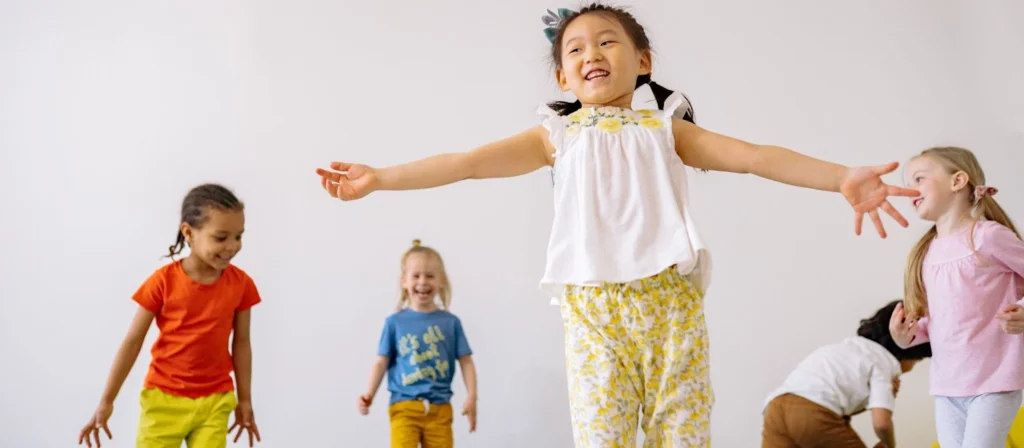
5.4 Spatial Awareness Activities
الوعي المكاني هو فهم كيفية ارتباط الأشياء والأشخاص ببعضهم البعض في الفضاء. يُعدّ تطوير الوعي المكاني أمرًا بالغ الأهمية لمرحلة ما قبل المدرسة، إذ يُرسي الأساس لمهارات أكاديمية لاحقة كالقراءة والرياضيات.
أمثلة على أنشطة الوعي المكاني
- دورات العوائق: Create an obstacle course with various objects that children need to navigate. Children practice spatial awareness by understanding the distance between themselves and objects as they weave through cones, crawl under tables, or jump over pillows.
- البحث عن الكنز:أنشئوا لعبة بحث عن الكنز، حيث يتعين على الأطفال العثور على أشياء مخفية بناءً على أدلة. تساعد هذه الألعاب الأطفال على ممارسة الوعي المكاني من خلال التنقل في بيئتهم.
- التنقل في المربعاستخدم صناديق كبيرة يستطيع الأطفال الزحف من خلالها أو التسلق عليها أو التنقل حولها. هذا يُساعد الأطفال على إدراك وضعية أجسامهم في الفضاء، ويُحسّن قدرتهم على الحركة في الفضاء المادي.
يُعدّ الوعي المكاني عنصرًا أساسيًا في المهارات الحركية الإدراكية. فهو يساعد الأطفال على فهم كيفية تحركهم في محيطهم، ويعزز قدرتهم على أداء مهام أكثر تعقيدًا.
5.5 Directional Awareness Activities
Directional awareness is understanding left, right, up, down, forward, and backward directions. These skills are essential for following instructions and coordinating physical movements.
أمثلة على أنشطة التوعية الاتجاهية
- اتباع التوجيهاتأعطِ الأطفال تعليمات توجيهية بسيطة، مثل "اقفز إلى اليسار"، أو "صفّق بيديك فوق رأسك"، أو "امشِ إلى اليمين". تساعد هذه التمارين الأطفال على التدرب على الاستماع واتباع التعليمات، مع تطوير المهارات الحركية الإدراكية.
- لعبة الحجلة:تساعد لعبة القفز على المربعات الأطفال على فهم الإشارات الاتجاهية واتباعها، مثل "القفز للأمام"، أو "الاستدارة"، أو "الخطوة إلى اليمين".
- حركات الرقص:العب لعبة حيث يقوم الأطفال بتقليد حركات الرقص الخاصة بك أو اتباع الحركات الاتجاهية مثل الانعطاف إلى اليسار أو الانحناء إلى الأسفل أو التقدم إلى الأمام.
تساعد أنشطة الوعي الاتجاهي الأطفال على تطوير المهارات اللازمة لاتباع التوجيهات والانخراط في مهام أكثر تعقيدًا لاحقًا.
5.6 Integration Activities
Integration activities are a fantastic way to combine multiple perceptual motor skills in a single task. These activities challenge preschoolers to coordinate fine and gross motor movements while integrating sensory input. By practicing these activities, children strengthen their ability to perform complex tasks that require various skills, working together.
أمثلة على أنشطة التكامل
- كرة الطائرة بالبالوناستخدم بالونًا لإنشاء لعبة كرة طائرة بسيطة. على الأطفال ضرب البالون بشكل متكرر مع البقاء ضمن منطقة محددة. يُشجّع هذا النشاط المهارات الإدراكية الحركية البصرية، حيث يتتبع الأطفال البالون، ويضبطون حركتهم وفقًا لذلك، ويستخدمون كلتا يديهم لتوجيه ضربات مدروسة.
- بناء الأبراج باستخدام الكتلاطلب من الأطفال استخدام مكعبات البناء لبناء أبراج عالية. أثناء تكديسهم للمكعبات، يُطورون مهاراتهم الحركية الدقيقة والكبيرة، حيث يتعين عليهم ضبط موضع كل مكعب بعناية، مع إدارة المهمة الجسدية المتمثلة في الرفع والتوازن. يُدمج هذا النشاط أيضًا الوعي المكاني، حيث يُحدد مكان كل قطعة.
- دورات العقبات ذات التحديات المتعددة: جهّز مسارًا مليئًا بالعقبات حيث يتعين على الأطفال الزحف والقفز والتوازن والتقاط الأشياء. يمكن أن يشمل ذلك القفز فوق الوسائد، أو التسلل بين المخاريط، أو التسلق تحت الطاولات. تُطوّر هذه المسارات المهارات الحركية الكبرى (مثل القفز والزحف) والمهارات الحركية الدقيقة (مثل التقاط الأشياء)، مع دمج المعالجة الحسية مع الحركات الجسدية.
أنشطة التكامل رائعة لأنها تتطلب من الأطفال التفكير السريع وتكييف حركاتهم وفقًا للإشارات الحسية المختلفة. أثناء ممارسة الأطفال لهذه الأنشطة، يتدربون على دمج المعلومات الحسية مع الحركات الجسدية، مما يعزز في نهاية المطاف تنسيقهم الحركي وتطورهم الحركي بشكل عام.


5.7 Balance Activities
يُعد التوازن من أهم المهارات الحركية الإدراكية التي يطورها أطفال ما قبل المدرسة، إذ يُشكل أساسًا لتنسيقهم الحركي. تُحسّن الأنشطة التي تُركز على التوازن الثبات والقوة والتنسيق والوعي المكاني. تُعد هذه المهارات حيوية لأنها تدعم المهام الجسدية الأكثر تعقيدًا، مثل الجري والقفز والكتابة.
أمثلة على أنشطة التوازن
- المشي على خطنشاط توازن بسيط وفعال، يتطلب من الأطفال المشي على خط مستقيم، كقطعة شريط لاصق على الأرض. يختبر هذا النشاط قدرتهم على الحفاظ على توازنهم أثناء الحركة للأمام. ولإضافة المزيد من التنوع، اطلب منهم المشي للخلف أو التوازن على قدم واحدة أثناء المشي على الخط، مع زيادة مستوى الصعوبة تدريجيًا.
- تمرين عارضة التوازنسواءً استخدمتَ عارضة توازن تجارية أو نسخةً منزلية الصنع مع شريط لاصق على الأرض، يُساعد هذا النشاط أطفال ما قبل المدرسة على تطوير توازنهم وتنسيقهم الحركي. يُمكنهم التدرب على المشي على عارضة التوازن، مما يُقوي عضلات الجذع، ويُحسّن تركيزهم.
- موازنة الأشياء:تحدى الأطفال بموازنة أشياء، مثل كيس فول أو كرة صغيرة، على رؤوسهم أثناء المشي أو الوقوف. يُشجّع هذا النشاط الأطفال على التحكم بأجسامهم ويساعدهم على تطوير قدرتهم على التركيز على الحفاظ على التوازن.
- الوقوف على ساق واحدةاطلب من الأطفال الوقوف على ساق واحدة والثبات على هذه الوضعية لبضع ثوانٍ. يمكنك جعل هذا أكثر متعةً بطلب منهم التظاهر بأنهم حيوانات مختلفة، مثل طيور الفلامنجو أو اللقلق. مع مرور الوقت، يُعزز هذا قوة العضلات ويُحسّن ثباتهم.
مثل هذه الأمثلة، تُعزز أنشطة التوازن المهارات الحركية الإدراكية وتساعد الأطفال على اكتساب الثقة بقدراتهم البدنية. كلما مارسوا الحفاظ على التوازن، ازدادت قدرتهم على التحكم بأجسامهم، مما قد يُترجم إلى مهام أخرى كالقفز والجري، وحتى تعلم الكتابة.

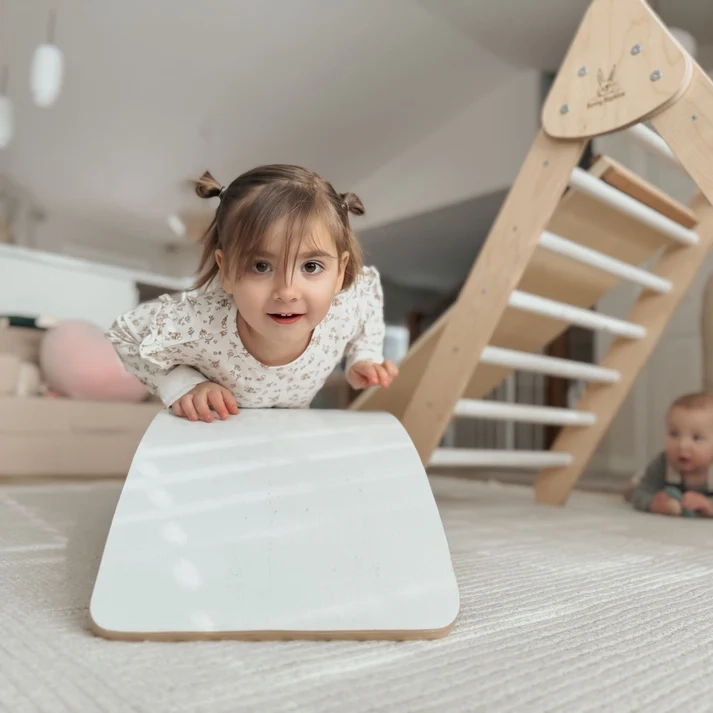
5.8 Expressive Activities
تساعد الأنشطة التعبيرية أطفال ما قبل المدرسة على استخدام أجسادهم للتعبير عن مشاعرهم وأفكارهم وقصصهم. تُعزز هذه الأنشطة المهارات الحركية الإدراكية، كالتنسيق والتوازن، وتشجع على التعبير العاطفي والإبداع.
أمثلة على الأنشطة التعبيرية
- الرقص والحركةدع الأطفال يتحركون بحرية على أنغام الموسيقى، وشجعهم على التعبير عن مشاعرهم كالسعادة والحماس والحزن من خلال حركاتهم. الرقص فرصة لتعزيز غرامoss motor skills and body awareness while allowing preschoolers to experiment with rhythm, timing, and coordination. You can add challenges like freeze dances or follow-the-leader movements to make it more interactive.
- لعب الأدوارتتيح أنشطة لعب الأدوار للأطفال استخدام خيالهم وحركاتهم الجسدية لتقمص شخصيات مختلفة أو تمثيل سيناريوهات متنوعة. سواءً كانوا يتظاهرون بدور حيوانات، أو أبطال خارقين، أو أشخاص عاديين، فإن لعب الأدوار يساعدهم على استخدام أجسادهم للتعبير عن أدوار ومشاعر مختلفة. يشجع هذا النوع من اللعب على الوعي الجسدي، والتوازن، والمهارات الحركية الدقيقة أثناء مشاركتهم في الحركات والإيماءات المرتبطة بأدوارهم.
- ألعاب البانتوميمفي هذه الألعاب، يستطيع الأطفال التعبير عن مشاعرهم وأفعالهم المختلفة دون كلام، معتمدين فقط على لغة جسدهم للتواصل. على سبيل المثال، يمكنك أن تطلب من الطفل تمثيل تمثيلية "أكل مخروط آيس كريم" أو "تسلق جبل". تساعد هذه الأنشطة الأطفال على استخدام أجسادهم بشكل إبداعي، كما تُحسّن مهاراتهم الإدراكية الحركية البصرية والوعي المكاني.
تتيح هذه الأنشطة التعبيرية للأطفال استكشاف المشاعر والأفكار أثناء تطوير المهارات الحركية والإدراكية بطرق ممتعة وإبداعية.

Receive a free catalog and custom layout to help you design your ideal classroom easily.
6. Which Skill Is an Example of a Perceptual Motor Skill?
المهارات الحركية الإدراكية هي القدرة على دمج المدخلات الحسية والاستجابات الحركية لأداء المهام التي تتطلب التنسيق. تُعد هذه المهارات أساسية لمختلف الأنشطة، بدءًا من الوظائف الأكاديمية كالكتابة ووصولًا إلى الأنشطة البدنية كالرياضة.
6.1 Perceptual Motor Skills and Movement Concepts
يُعد فهم كيفية تفاعل المهارات الإدراكية والحركية مع مفاهيم الحركة أمرًا أساسيًا لدعم نمو طفل ما قبل المدرسة. تشمل مفاهيم الحركة هذه فهم العلاقات المكانية، والحركات الاتجاهية، والتوازن، والتوقيت، وكلها تساعد الأطفال على فهم بيئتهم المادية.
عامل تأثير المهارات الإدراكية والحركية
يؤثر تطور المهارات الحركية الإدراكية بشكل مباشر على قدرة الطفل على الحركة بفعالية وفهم عالمه المادي. على سبيل المثال، يستطيع أطفال ما قبل المدرسة ذوو المهارات الحركية الإدراكية القوية اتباع تعليمات مثل "اركض للأمام" أو "اقفز لأعلى" بسهولة أكبر، إذ يتقنون تنسيق المدخلات الحسية والحركة.
أمثلة على المهارات الحركية الإدراكية ومفاهيم الحركة
Some activities that incorporate perceptual motor skills and movement concepts include following complex directions in dance, moving through obstacle courses, or participating in group sports. These activities require children to adjust their movements based on sensory feedback, enhancing their perceptual motor coordination.

6.2 Developing Ocular Motor and Visual Perceptual Skills
Ocular motor and visual perceptual skills are essential for the eyes to track, focus, and interpret visual information. These skills support reading, writing, hand-eye coordination, and spatial awareness—core components of early learning. Strengthening them in preschoolers helps improve attention, visual memory, and the ability to recognize patterns or letters. Activities like tracing, mazes, and visual matching games effectively promote development. By focusing on these foundational visual motor and visual perceptual skills, children build the visual efficiency needed for academic and everyday success. Consistent practice boosts school readiness and enhances confidence in physical and classroom tasks.

7. Differences in Perceptual Motor Skill between Infants, Toddlers, and Preschoolers
| وجه | Infants (0–12 months) | Toddlers (1–3 years) | Preschoolers (3–5 years) |
|---|---|---|---|
| المهارات الحركية الكبرى | Start walking, climbing, running, pushing, and pulling toys | Improve coordination in running, jumping, hopping, and balancing | Grasping objects, reaching, and hand-to-mouth movement |
| المهارات الحركية الدقيقة | Scribbling, stacking blocks, and using spoons | Drawing shapes, using scissors, and completing puzzles | Respond to light, sound, and texture passively |
| Visual Motor Integration | Tracking faces/toys, recognizing contrast | Improved hand-eye coordination through simple play | Precise visual tracking and motor control for drawing/writing tasks |
| Sensory Processing | Can follow complex movement directions, and improved body control | Active exploration using all senses | Use sensory cues to guide purposeful movement |
| Body Awareness | Limited to spontaneous movement and reflexes | Understand body parts, mimic gestures | Can follow complex movement directions, and has improved body control |
| Spatial Awareness | Minimal; start recognizing caregivers’ distance | Begin navigating space, avoiding obstacles | Navigate environments confidently with improved spatial judgment |
| Directional Awareness | Absent; movement is reactive | Begin understanding in/out, up/down | Understand left/right, forward/backward in structured tasks |
| Motor Planning | Primitive; trial-and-error movement | Basic planning, trial strategies during play | Intentional actions with goal-directed movement |
الأسئلة الشائعة
1. ما هي المهارات الحركية الإدراكية بعبارات بسيطة؟
Perceptual motor skills involve interpreting sensory information and responding with coordinated physical movements. They are crucial for both cognitive development and physical tasks.
2. كيف يمكنني تحسين المهارات الإدراكية الحركية لطفلي في مرحلة ما قبل المدرسة؟
شجع الأنشطة مثل الرسم والجري والقفز ولعب الألعاب التي تتطلب التنسيق البدني والمعالجة الحسية لتحسين المهارات الحركية الإدراكية.
3. لماذا تعتبر المهارات الحركية الإدراكية ضرورية لمرحلة ما قبل المدرسة؟
المهارات الحركية الإدراكية أساسية للتعلم الأكاديمي والصحة البدنية والنمو العاطفي. فهي تساعد الأطفال على أداء مهام مثل الكتابة والقراءة والمشاركة في الأنشطة الاجتماعية.
4. ما هي بعض الأمثلة على المهارات الحركية الإدراكية لمرحلة ما قبل المدرسة؟
Examples include running, jumping, drawing, catching a ball, and completing puzzles. These activities help preschoolers develop both visual motor and visual perceptual skills.
5. كيف يمكنني مساعدة طفلي على تطوير المهارات الحركية الإدراكية ومفاهيم الحركة؟
دمج الأنشطة التي تتحدى كل من المعالجة الحسية والحركة الجسدية، مثل البناء بالمكعبات، أو لعب ألعاب الكرة، أو المشاركة في مسارات العقبات.
6. ما هي أفضل طريقة لتطبيق برنامج المهارات الحركية الإدراكية في المنزل؟
لتعزيز المهارات الحركية الإدراكية، قم بإنشاء روتين منظم يشمل الأنشطة البدنية الداخلية والخارجية، مثل الرقص والجري والبناء.
خاتمة:
Incorporating perceptual motor skills activities into a preschooler’s routine is essential for fostering well-rounded development. Activities like balance exercises, integration tasks, and expressive activities enhance physical coordination and improve cognitive abilities such as spatial awareness, body control, and emotional expression. Preschoolers strengthen fine and gross motor skills by engaging in diverse activities, boosting creativity and confidence. The more these activities are integrated into daily routines, the better children will develop the foundational skills for academic success, social interactions, and overall well-being. These early experiences play a key role in preparing children for more complex tasks as they grow.







